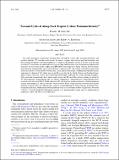Seasonal Cycles of Along-Track Tropical Cyclone Maximum Intensity
Author(s)
Gilford, Daniel M.; Susan, Solomon; Emanuel, Kerry Andrew
DownloadPublished version (1.600Mb)
Publisher Policy
Publisher Policy
Article is made available in accordance with the publisher's policy and may be subject to US copyright law. Please refer to the publisher's site for terms of use.
Terms of use
Metadata
Show full item recordAbstract
This study investigates relationships between observed tropical cyclone (TC) maximum intensities and potential intensity (PI) over the seasonal cycle. To directly compare observed and potential intensities, one must account for month-to-month variability in TC tracks and frequencies. Historical TC best track data and reanalysis PI calculations are combined to develop an along-track record of observed maximum and potential intensities for each storm in the satellite-era (1980-2015) across four ocean basins. Overall, observed maximum intensity seasonal cycles agree well with those of along-track PI. An extreme value theory application shows that at least 25 storms must be observed in a given month to have high confidence that the most intense wind speeds of historical TCs follow along-track PI seasonality. In the North Atlantic and Southern Hemisphere regions, there are too few observed storms outside their traditional TC seasons, limiting PI applicability across the seasonal cycle. Small intraseasonal along-track PI variabilities in these regions are driven by TC thermodynamic disequilibrium and sea surface temperatures. Thermodynamic disequilibrium drives seasonal cycles of eastern North Pacific along-track PI and observed maximum intensity, which minimize in August and maximize in June and October. Western North Pacific along-track PI and observed maximum intensity seasonal cycles are relatively flat, and have a local minimum in August because of reduced thermodynamic efficiency, which is linked to anomalously warm near-tropopause outflow temperatures. Powerful ( > 65ms[superscript -1]) western Pacific TCs historically occur in every month except January, due to a combination of tropopause region and SST seasonal influences.
Date issued
2019-04Department
Massachusetts Institute of Technology. Department of Earth, Atmospheric, and Planetary SciencesJournal
Monthly Weather Review
Publisher
American Meteorological Society
Citation
Gilford, Daniel M., et al. “Seasonal Cycles of Along-Track Tropical Cyclone Maximum Intensity.” Monthly Weather Review 147, 7 (July 2019): 2417–32. © 2019 American Meteorological Society.
Version: Final published version
ISSN
1520-0493
0027-0644